Most Recent CFA Institute CFA-Level-II Exam Dumps
Prepare for the CFA Institute CFA Level II Chartered Financial Analyst exam with our extensive collection of questions and answers. These practice Q&A are updated according to the latest syllabus, providing you with the tools needed to review and test your knowledge.
QA4Exam focus on the latest syllabus and exam objectives, our practice Q&A are designed to help you identify key topics and solidify your understanding. By focusing on the core curriculum, These Questions & Answers helps you cover all the essential topics, ensuring you're well-prepared for every section of the exam. Each question comes with a detailed explanation, offering valuable insights and helping you to learn from your mistakes. Whether you're looking to assess your progress or dive deeper into complex topics, our updated Q&A will provide the support you need to confidently approach the CFA Institute CFA-Level-II exam and achieve success.
The questions for CFA-Level-II were last updated on May 2, 2025.
- Viewing page 1 out of 143 pages.
- Viewing questions 1-5 out of 715 questions
Joan Fisher and Kim Weatherford are economists responsible for modeling security returns for Quincy Portfolio Managers, which is located in the southwestern United States. Fisher is the firm's chief economist and Weatherford is her assistant.
Fisher has been busy over the past week modeling the macroeconomic data of an emerging market. The data for the past 24 months is shown in Exhibit 1.
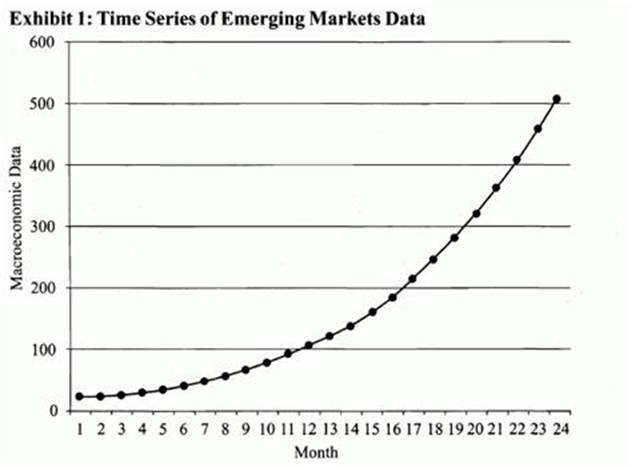
Fisher ponders how she can run a regression that will model the data for this country in the most appropriate way. She decides to regress the macroeconomic values against a time variable. The resulting plot of the residuals is shown in Exhibit 2.
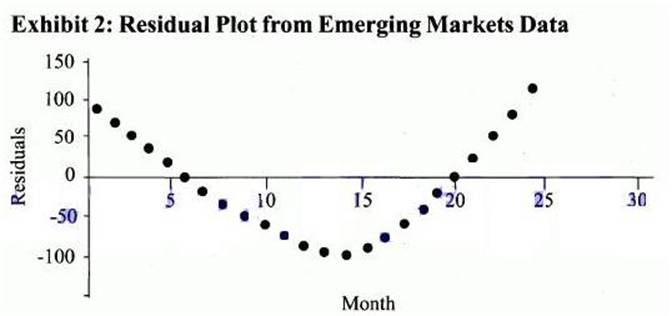
In addition to financial assets, Quincy Portfolio Managers also recommends the use of commodities as a portfolio diversifier. Weatherford has been examining price indices for silver in an attempt to determine whether silver returns are predictable. As an initial step, she uses an autoregressive first-order regression model on daily price data for silver over the past two years. The plot of the raw data and the results of the regression are shown in Exhibits 3 and 4.
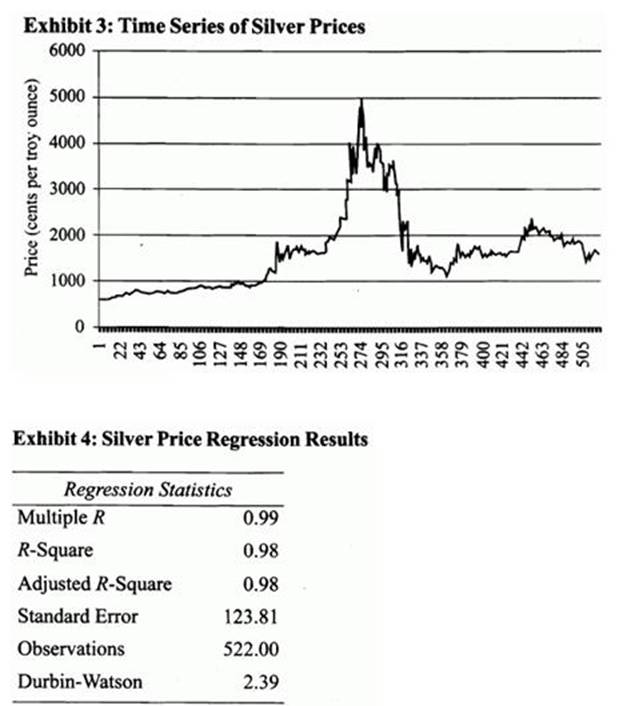
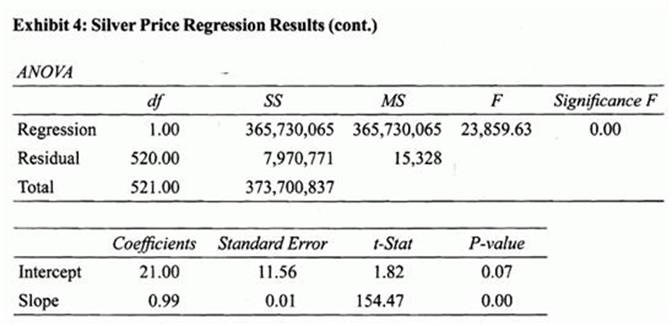
Fisher and Weatherford later discuss fluctuations in gold prices. Although the arithmetic and geometric mean returns for gold were negative for much of the 1980s and 1990s, Fisher and Weatherford believe that gold should perform better in the future due to higher expected inflation. After appropriate transformation of the data, they use an autoregressive first-order regression model to examine the characteristics of gold returns, the results of which are shown in Exhibit 5.
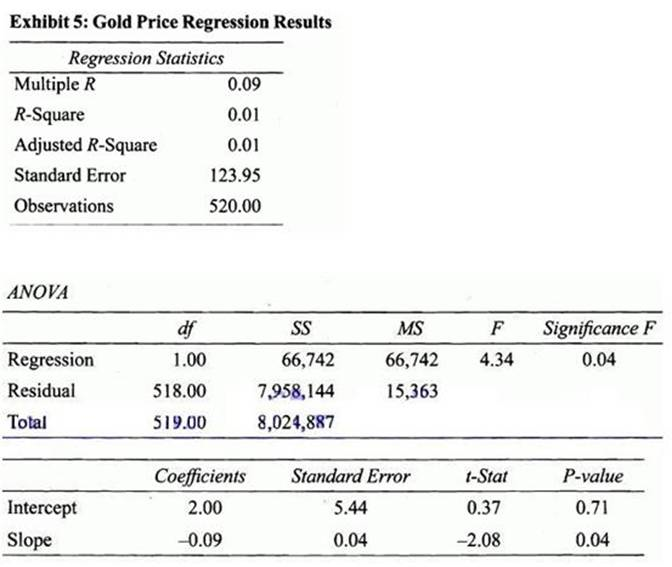
The most likely problem in Fisher's regression of the emerging market data and the most appropriate test for it in the regression are:
Problem Test
The most likely problem in Fisher's regression of the emerging market data is that the error terms appear to be positively correlated in Exhibit 2. The first few error terms are positive, then negative, and then positive. This indicates serial correlation, which is common in trend models. As Fisher regresses the macroeconomic data against a time variable, she is using a trend model. In a trend model, the Durbin Watson statistic can be used to detect serial correlation. (Study Session 3, LOS 12.g)
The Wyroman International Pension Fund includes a $65 million fixed-income portfolio managed by Susan Evermore, CFA, of Brighton Investors. Evermore is in the process of constructing a binomial interest-rate tree that generates arbitrage-free values for on-the-run Treasury securities. She plans to use the tree to value more complex bonds with embedded options. She starts out by observing that the yield on a one-year Treasury security is 4.0%. She determines in her initial attempt to price the two-year Treasury security that the value derived from the model is higher than the Treasury security's current market price.
After several iterations Evermore determines that the interest rate tree that correctly values the one and two-year Treasury securities has a rate of 5.0% in the lower node at the end of the first year and a rate of 7.5% in the upper node at the end of the first year. She uses this tree to value a two-year 6% coupon bond with annual coupon payments that is callable in one year at 99.50. She determines that the present value at the end of the first year of the expected value of the bond's remaining cash flows is $98.60 if the interest rate is 7.5% and $100.95 if the interest rate is 5.0%.
Note: Assume Evermore's calculations regarding the two-year 6% callable bond are correct
Evermore also uses the same interest rate tree to price a 2-year 6% coupon bond that is putable in one year, and value the embedded put option. She concludes that if the yield volatility decreases unexpectedly, the value of the putable bond will increase and the value of the embedded put option will also increase, assuming all other inputs are unchanged.
Evermore also uses the interest rate tree to estimate the option-adjusted spreads of two additional callable corporate bonds, as shown in the following figure.

Evermore concludes, based on this information, that the A A-rated issue is undervalued, and the BB-rated issue is overvalued.
At a subsequent meeting with the trustees of the fund. Evermore is asked to explain what a binomial interest rate model is and how it was used to estimate effective duration and effective convexity. Evermore is uncertain of the exact methodology because the actual calculations were done by a junior analyst, but she tries to provide the trustees with a reasonably accurate step-by-stcp description of the process:
Step 1: Given the bond's current market price, the on-the-run Treasury yield curve, and an assumption about rate volatility, create a binomial interest rate tree.
Step 2: Add 100 basis points to each of the 1-year rates in the interest rate tree to derive a "modified" tree.
Step 3: Compute the price of the bond if yield increases by 100 basis points using this new tree.
Step 4: Repeat Steps 1 through 3 to determine the bond price that results from a 100 basis point decrease in rates.
Step 5: Use these two price estimates, along with the original market price, to calculate effective duration and effective convexity.
Lucas Davenport, a trustee and university finance professor, immediately speaks up to disagree with Evermore. He claims that a more accurate description of the process is as follows:
Step 1: Given the bond's current market price, the Treasury yield curve, and an assumption about rate volatility, create a binomial interest rate tree and calculate the bond's option-adjusted spread (OAS) using the model.
Step 2: Impose a parallel upward shift in the on-the-run Treasury yield curve of 100 basis points.
Step 3: Build a new binomial interest rate tree using the new Treasury yield curve and the original rate volatility assumption.
Step 4: Add the OAS from Step I to each of the 1-year rates on the tree to derive a "modified" tree.
Step 5: Compute the price of the bond using this new tree.
Step 6: Repeat Steps 1 through 5 to determine the bond price that results from a 100 basis point decrease in rates.
Step 7: Use these two price estimates, along with the original market price, to calculate effective duration and effective convexity.
At the meeting with the trustees. Evermore also presents the results of her analysis of the effect of changing market volatilities on a 1-year convertible bond issued by Highfour Corporation. Each bond is convertible into 25 shares of Highfour common stock. The bond is also callable at 110 at any time prior to maturity. She concludes that the value of the bond will decrease if either (1) the volatility of returns on'Highfour common stock decreases or (2) yield volatility decreases.
Davenport immediately disagrees with her by saying "changes in the volatility of common stock returns will have no effect on the value of the convertible bond, and a decrease in yield volatility will result in an increase in the value of the bond."
Is Evermore correct in her analysis of the effect of a change in yield volatility?
The value of a putable bond is equal to the value of an otherwise equivalent option-free bond plus the value of the embedded put option. The value of the embedded put option will decrease if yield volatility decreases. The value of the option-free bond will not be affected by changes in yield volatility, so the value of the putable bond will also decrease. Evermore is incorrect in her analysis of both effects. (Study Session 14, LOS 54.e,f)
Jason Bennett is an analyst for Valley Airlines (Valley), a U .S . firm. Valley owns a stake in Southwest Air Cargo (Southwest), also a U .S . firm. The two firms have had a long-standing relationship. The relationship has become even closer because several of Valley's top executives hold seats on Southwest's Board of Directors.
Valley acquired a 45% ownership stake in Southwest on December 31, 2007. Acquisition of the ownership stake cost $9 million and was paid in cash. Valley's stake in Southwest is such that management can account for the investment using either the equity method or the acquisition method. While Valley's management desires to fairly represent the firm's operating results, they have assigned Bennett to assess the impact of each method on reported financial statements.
Immediately prior to the acquisition. Valley's current asset balance and total equity were $96 million and $80 million, respectively. Southwest's current assets and total equity were $32 million and $16 million, respectively.
While analyzing the use of the equity method versus the acquisition method, Bennett calculates the return on assets (ROA) ratio. He arrives at two conclusions:
Statement 1: Compared to the acquisition method, the equity method results in a higher ROA because of the higher net income under the equity method.
Statement 2: Compared to the acquisition method, the equity method results in a higher ROA because of the smaller level of total assets under the equity method.
In order to get a better picture of Valley's operating condition, Bennett is also considering the use of proportionate consolidation to account for Southwest. He makes the following statements regarding the acquisition method and a proportionate consolidation:
Statement 3: Both methods are widely accepted under the provisions of U .S . GAAP and International Financial Reporting Standards (IFRS).
Statement 4: Both methods report the same level of assets on the parent's balance sheet.
Statement 5: Both methods report all of Southwest's liabilities on the parent's balance sheet.
In addition. Valley has always wanted to pursue its goal of vertical integration by expanding its scope of operations to include the manufacturing of airline parts for its own airplanes. Therefore, it established a subsidiary, Mountain Air Parts (Mountain), in Switzerland on January 1,2008. Switzerland was chosen as the location for economic and geographical diversification reasons. Mountain will operate as a self-contained, independent subsidiary. Local management in Switzerland will make the majority of operating, financing, and investing decisions.
The Swiss franc (CHF) is the official currency in Switzerland. On January 1, 2008, the USD/CHF exchange rate was 0.77. At December 31, 2008, the exchange rate had changed to 0.85 USD/CHF. The average exchange rate in 2008 was 0.80 USD/CHF. In its first year of operations. Mountain paid no dividends and no taxes. Mountain uses the FIFO assumption for its flow of inventory.
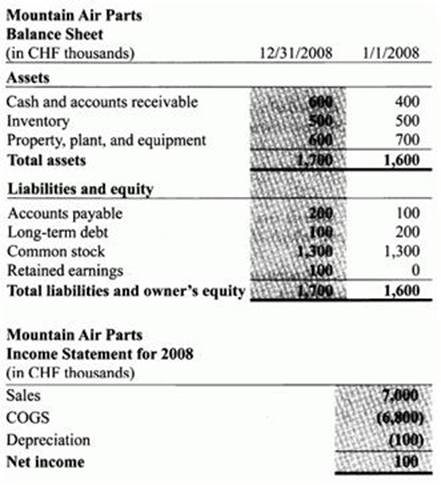
How many of Bennett's statements on proportionate consolidation are correct?
Proportionate consolidation only considers the proportion of the assets and liabilities owned by the parent firm (Statements 4 and 5 are incorrect). Also, proportionate consolidation is generally not allowed under U .S . GAAP (Statement 3 is incorrect). Proportionate consolidation is the preferred method under IFRS. Therefore, none oft three statements is correct. (Study Session 5. LOS 21.b)
Russell Larson, CFA, is an investment analyst for Sentry Properties, Inc., a group of wealthy investors that is currently interested in purchasing Riviera Terrace, a 60- unit apartment complex in Southeastern Florida. The current owners of Riviera Terrace have agreed to sell the property for $40,000,000. Larson estimates that Rivjera Terrace's net operating income for the first year after the sale is finalized will be $4,200,000, and it is expected to maintain its historic annual growth rate of 5%.
At Sentry's request, Larson will evaluate the investment in Riviera Terrace over a 5-year horizon using selling prices of $45,000,000 and S60,000,000.
During the due diligence process, Larson has determined that the average selling price for apartment complexes similar to Riviera Terrace is $1,250,000 per unit, with annual net operating income equal to $ 135,000 per unit. Larson has also determined that net operating income is typically 80% of gross income.
Larson has collected the following information to aid in his evaluation of Riviera Terrace.
* The property will be fully depreciated at a rate of S 1,250,000 per year over 32 years.
* Rental contracts are expected to be reissued on the date the sale is completed.
* Sentry has arranged to finance the investment with a 30-ycar, 7% interest-only loan, with monthly payments and a face value equal to 80% of the initial investment.
* Selling expenses will be 7% of the gross selling price.
* The capital gains tax rate is 15%, the tax on recaptured depreciation is 28%, and the tax rate on ordinary income is 40%.
* Sentry Properties' required return on equity is 20%.
* The interest rate on U .S . government bonds after adjustments for real estate based tax savings = 5.0%.
* The premium investors require for the illiquidity of real estate investments = 2.5%.
* The average real estate return net of appreciation = 1.25%.
* The real estate investment risk premium = 3.0%.
* The average internal rate of return for properties that are comparable to Riviera Terrace is 22%.
As part of the diligence process, Larson deems it to be appropriate to estimate the.market value of Riviera Terrace using capitalization rates based on the market extraction and built-up methods. One of the partners in Sentry Properties has also asked Larson to estimate the market value of Riviera Terrace using: (1) the direct income capitalization approach and (2) the gross income multiplier approach.
There are several indicators that the Florida real estate market may take a downward turn over the next five years. With this in mind, Larson determines that there is a reasonable chance that Sentry will have to terminate its investment in Riviera Terrace at the end of year 3 at the initial purchase price of $40,000,000. Under this scenario, he estimates the equity reversion after tax (ERAT) in year 3 to be $4,934,000. Cash flow after tax in years 1 and 2 are $1,676,000 and $1,802,000, respectively.
The highest estimated capitalization rate for Riviera Terrace, comparing the market extraction method and the built-up method, is closest to:
Market extraction method:

(Study Session 13, LOS 46.b)
Arnaud Aims is assisting with the analysis of several firms in the retail department store industry. Because one of the industry members, Flavia Stores, has negative earnings for the current year, Aims wishes to normalize earnings to establish more meaningful P/E ratios. For the current year (2008) and six previous years, selected financial data are given below. All data are in euros.

Aims wishes to estimate normalized EPS for 2008 using two different methods, the method of historical average EPS and the method of average rate of return on equity. He will leave 2008 EPS and ROI out of his estimates. Based on his normalized EPS estimates, he will compute a trailing P/E for 2008. The stock price for Flavia Stores is 26.50.
Aims is also looking at price-to-book ratios as an alternative to price-to-earnings ratios. Three of the advantages of P/B ratios that Aims recalls are:
Advantage 1: Because book value is a cumulative balance sheet account encompassing several years, book value is more likely to be positive than EPS.
Advantage 2: For many companies, especially service companies, human capital is more important than physical capital as an operating asset.
Advantage 3: Book value represents the historical purchase cost of assets, as well as accumulated accounting depreciation expenses. Inflation and technological changes can drive a wedge between the book value and market value of assets.
Aims used a constant growth DDM to establish a justified P/E ratio based on forecasted fundamentals. One of his associates asked Aims if he could easily establish a justified price-to-sales (P/B) ratio and price-to-book (P/B) ratio from his justified P/E ratio. Aims replied, "I could do this fairly easily)
If I multiply the P/E ratio times the net profit margin, the ratio of net income to sales, the result will be the P/S ratio. If I multiply the P/E ratio times the return on equity, the ratio of net income to book value of equity, the result will be the P/B ratio."
Aims's associate likes to use the price-earnings-to-growth (PEG) ratio because it appears to address the effect of growth on the P/E ratio. For example, if a firm's P/E ratio is 20 and its forecasted 5-year growth rate is 10%, the PEG ratio is 2.0. The associate likes to invest in firms that have an above-industry-average PEG ratio. The associate also says that he likes to invest in firms whose leading P/E is greater than its trailing P/E. Aims tells the associate that he would like to investigate these two investment criteria further.
Finally, Aims makes two comments to his associate about valuation ratios based on EBITDA and on dividends.
Comment 1: EBITDA is a pre-interest-expense figure, so I prefer a ratio of total equity value to EBITDA over a ratio of enterprise value to EBITDA .
Comment 2: Dividend yields are useful information because they are one component of total return. However, they can be an incomplete measure of return, as investors trade off future earnings growth to receive higher current dividends.
Using the information in Exhibit 1, estimate the 2008 P/E ratio for Flavia Stores using the method of historical average EPS. The P/E ratio is closest to:
Normalizing EPS using the method of average EPS is accomplished by averaging the EPS over the six-year period from 2002-2007:
EPS(normalized) = (1.90 + 1.65 + 0-99 + 1.35 + 0.77 + 1.04) / 6 = 1.283. The P/E ratio based on this normalized EPS is 26.5 / 1.283 = 20.649. (Study Session 12, LOS 42.f,g)
Unlock All Questions for CFA Institute CFA-Level-II Exam
Full Exam Access, Actual Exam Questions, Validated Answers, Anytime Anywhere, No Download Limits, No Practice Limits
Get All 715 Questions & Answers